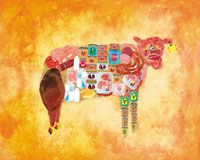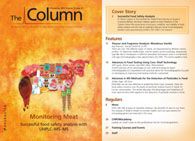Successful Food Safety Analysis
Dr Kevin Cooper of the Institute for Global Food Security at Queen's University Belfast, Northern Ireland, spoke to Kate Mosford of The Column about the importance of accuracy, reliability, and stability in food safety analysis and the role of ultrahigh-pressure liquid chromatography tandem mass spectrometry (UHPLC–MS–MS) in his research.
Dr Kevin Cooper of the Institute for Global Food Security at Queen's University Belfast, Northern Ireland, spoke to Kate Mosford of The Column about the importance of accuracy, reliability, and stability in food safety analysis and the role of ultrahigh-pressure liquid chromatography tandem mass spectrometry (UHPLC–MS–MS) in his research.
Photo Credit: Fanatic Studio/Getty Images

Q. What are your key research interests?
A: Quantifying chemical contaminants in the food chain in the broadest sense is where my interest lies. My background is in the measurement of residues of veterinary medicines in food and livestock. Coming from a farming background in a country where agri-food production remains the largest industry, and with a degree in the physiology and biochemistry of farm animals, it was a natural move into laboratory-based food safety analysis, particularly when there was the opportunity of occasional animal feeding trials to get me back out on the farm.
Q. You have worked in both a residue testing laboratory and an academic research department. Could you talk us through your experiences of working in food chain analyses in these two different laboratories?
A: You can't get a better grounding in chromatographic and immunoassay techniques than working in a national residues monitoring laboratory with a strong R&D ethos. I was fortunate to spend 15 years as a University Research Fellow in the Chemical Surveillance Branch of the Agri-Food and Biosciences Institute of Northern Ireland (AFBI), a UKAS accredited EU National Reference Laboratory for veterinary residues, which is responsible for the Northern Ireland Residues Monitoring Plan. AFBI works under EU legislation, with the possibility of analytical results being presented as evidence in court should prosecutions for abuse of veterinary medicines be brought.
This environment instills a rigour in the quality of the analytical methods, with accuracy, reliability, and stability being crucial. Thorough method validation is important to successful food safety analysis: European Commission Decision 2002/6571 on the performance criteria of analytical methods is central. I learned the importance of ensuring the purity and stability of standard materials; working to ISO 9001, 17025, and GLP standards; developing methods that are robust and usable in a high-throughput food monitoring laboratory; working to standard operating procedures; and the avoidance of cross-contamination when analyzing complex food matrices for sub-parts-per-billion concentrations of small molecules. Nitrofuran antibiotic residues became a focus of my research at AFBI when we were instrumental in uncovering the widespread misuse of these banned drugs in various food industries,2 disseminated chromatographic analytical techniques globally,3 and developed ELISA screening methods4,5 - the novel immunogen chemistry of which has since been widely adopted. At that time there was some confusion over how to detect misuse of nitrofurazone, with evidence that its marker residue in animal tissues, semicarbazide, could arise from other natural sources. While subsequent studies suggested possible alternative marker residues,6–9 this issue is still not fully resolved, with semicarbazide still regularly reported in the European Rapid Alert System for Feed and Food in a variety of foodstuffs, particularly aquaculture products.
The advances in mass spectrometry (MS) hardware and data handling in recent years have seen an ongoing move towards multi-residue analytical methods, sometimes including different classes of drugs, using generic extraction techniques such as QuEChERS, despite the additional headaches this raises for routine method quality control in a regulatory setting. Under one of the largest EU FP6 research projects, ProSafeBeef, I was involved in developing an ultrahigh-pressure liquid chromatography tandem mass spectrometry (UHPLC–MS–MS) method for a wide range of anthelmintic residues (anti-worm and fluke livestock medications) and surveying their occurrence in European beef.10
The experience and disciplines gained in AFBI were invaluable when I moved to the Institute for Global Food Security (IGFS) in 2010. As an expanding academic research institute within Queen's University Belfast (QUB), IGFS has the freedom to take its research wherever the funding and curiosity allows. In the university research setting similar techniques are employed but there is greater scope to experiment with different instrumentation and the potential targets for analysis in food are endless. Whilst laboratory accreditation is less realistic and a lesser degree of method validation is required in the academic R&D setting, we advocate aspiring to Decision 2002/657 standards of validation, particularly for analysis of suspected human carcinogens in the food chain, to encourage robust analyses, and as a means to teach the principles of method validation to graduate and postgraduate students.
Cross-disciplinary collaborations are another advantage of the university setting. Analysis of chemicals in food is a highly regulated area, breeding analysts with enviable expertise in the accurate quantification of trace compounds in complex matrices. Is it a stretch to say that food chain analysts want accurate quantitative data while human clinical or medical researchers are often more concerned with qualitative effects? Colleagues in the QUB Centre for Cancer Research and Cell Biology approached IGFS to avail of our expertise in quantitative UHPLC–MS–MS. I quantified isomeric metabolites of estradiol in cell cultures. Separation of the isomers of hydroxyestradiol was crucial as the study was elucidating metabolic pathways regulated by the BRCA1 gene mutation, which predisposes carriers to a high incidence of breast and ovarian cancers. Baseline separation was achieved using a pentafluorophenyl column. This work provided quantitative confirmation that potentially carcinogenic metabolites of estradiol are increased in BRCA1-depleted cells.11 So the world of food safety inevitably overlaps with human clinical studies and the skills learned in residues testing in foods can be widely applied in other fields.
Q. What are you currently working on?
A: Carcinogenic heterocyclic amines (HCA) - produced when meat is cooked - have been a recent interest. We have measured HCAs using UHPLC–MS–MS. Interestingly, even with well-established chromatographic methods, there can be room for improvement. Baseline separation and sensitivity of certain HCA isomers was, I found, greatly improved under positive mode electrospray ionization when using a pH 9.5 mobile phase (C18 column) - to our knowledge the first report of HCA separation under alkaline LC conditions.12 By applying this detection to human blood samples that had been subjected to a wide range of hydrolysis conditions, I recently demonstrated conclusively that acid-labile HCA-blood protein adducts are not viable biomarkers of dietary HCA exposure (manuscript under review). We are now turning our attention to metabolomic profiling of these blood samples.
A neglected aspect of veterinary residues in food is the effect of cooking on the hazards posed by harmful residues. Does cooking make our food any safer? I have previously performed cooking studies on meat containing residues of banned nitrofuran drugs13 and legal anthelmintic compounds,14 and we are in the process of publishing our latest cooking study of nitroimidazole drug residues in prawns.15 Stability of residues during cooking can vary between compounds, but generally veterinary drug residues are resistant to conventional cooking. With the move towards more risk-based analysis of food safety in Europe, this sort of data is valuable for dietary exposure and risk assessments.
At IGFS the food chain is seen to be integral to the wider feed-and-food chain; animal feed quality and safety will impact the food we consume. Consequently we also work with the animal feed industry. I am currently collaborating closely with a specialist animal feed manufacturer, investigating new techniques to enhance product quality control; for example, using x-ray fluorescence to rapidly measure critical mineral contents of premix feeds.
Q. Why is liquid chromatography coupled to mass spectrometry (LC–MS) your analytical method of choice?
A: Simply put the flexibility and diversity of LC–MS is ideal for analysis of small molecules in biological matrices and the constantly evolving hardware allows the range of research in our labs to also evolve. Our IGFS laboratories are recognized as a Waters Center of Innovation, with a range of LC–MS(MS) instrumentation.
Our interest in using LC–TOF-MS in metabolomic studies is growing. We have had some success in identifying potential biomarkers of 5-nitroimidazole drug treatment in pig tissues and even potential markers for early diagnosis of Alzheimer's Disease in humans.16 Upcoming studies include searching for biomarkers of steroid hormone abuse in food animals. Biotoxins analysis is another major focus and we use UHPLC–MS–MS for targeted analysis of a large range of mycotoxins in foods. While we do use gas chromatography (GC) for fatty acid analysis and headspace analysis of volatiles in foods, and isotope-ratio MS for studies of the geographic origins of food, LC remains our core separation technique. This has recently extended to ion chromatography (IC) coupled to inductively coupled plasma mass spectrometry (ICP–MS), which we use for elemental analysis. Arsenic speciation in rice and baby foods is the current hot topic on this platform
Q. With so much media attention now surrounding what we eat, have you seen a trend towards a more healthy diet and knowledge of what is in our food?
A: Media interest has certainly brought to light increasing numbers of food scares and a greater suspicion of what is in the food we eat. However, colleagues in the ProSafeBeef project demonstrated that consumers often do not distinguish between microbiological and chemical risks in their food ("bugs and drugs") and that safe food is perceived simply as food that is not bad for consumers' health.17 People certainly want healthier and cleaner food but there is a poor understanding of the real risks associated with chemical contaminants. The plethora of news headlines about "Cancer Chemicals in Food" show the difficulty of conveying the nature of risks or hazards and the fact that everything is a chemical. It is my impression that most people struggle to define and respond, if at all, to food safety risks. Food authenticity, and the food fraud which is often behind it, is currently of greater concern. Our director at IGFS, Prof Chris Elliott, recently completed a major review of the UK's food supply networks for the British Government18 and made many fundamental recommendations under a national food crime prevention framework, prompted by the horsemeat scandal uncovered in early 2013.
Q. Where will your research take you in the future?
A: As we develop our metabolomics capability in IGFS we have begun to see the need to combine the untargeted and targeted approaches to biomarker discovery. Learning how to apply my experience of targeted quantification within semi-targeted metabolomics is a whole new world of possibilities. Recent collaborations with industry have also brought home to me again how our academia-based R&D needs to be applicable to the commercial setting - not an easy task with chromatographic techniques. Can our analyses be applied in the production factory? What level of accuracy and validation is needed in each environment? And I suspect I will always be interested in veterinary drug residues in food. I recently reviewed the impact of climate change on residues in food from an island of Ireland perspective.19 The profile of drug residues in our food will change in the years ahead, requiring ever-evolving monitoring techniques.
References
1. European Commission Decision 2002/657/EC. Off. J. Eur. Comm. L221, 8–36 (2002).
2. M. O'Keeffe, A. Conneely, K.M. Cooper, D.G. Kennedy, L. Kovacsics, A. Fodor, P.J. Mulder, J.A. van Rhijn, and G. Trigueros, Anal. Chim. Acta 520, 125–131 (2004).
3. K.M. Cooper, P.P.J. Mulder, J.A. van Rhijn, L. Kovacsics, R.J. McCracken, P.B. Young, and D.G. Kennedy, Food Addit. Contam. 22, 406–414 (2005).
4. K.M. Cooper, A. Caddell, C.T. Elliott, and D.G. Kennedy, Anal. Chim. Acta 520, 79–86 (2004).
5. K.M. Cooper, J.V. Samsonova, L. Plumpton, C.T. Elliott, and D.G. Kennedy, Anal. Chim. Acta 592, 64–71 (2007).
6. J.V. Samsonova, A.J. Douglas, K.M. Cooper, D.G. Kennedy, and C.T. Elliott, Food Chem. Toxicol. 46, 1548–1554 (2008).
7. K.M. Cooper, R.J. McCracken, and D.G. Kennedy, Analyst 130, 824–827 (2005).
8. Y. Wang, E.L.E. Jester, K.R. El Said, A. Abraham, J. Hooe-Rollman, and S.M. Plakas, J. Agric. Food Chem. 58, 313–316 (2010).
9. P.P.J. Mulder, B. Beumer, and J.A. Van Rhijn, Anal. Chim. Acta 586, 366–373 (2007).
10. K.M. Cooper, M. Whelan, D.G. Kennedy, G. Trigueros, A. Cannavan, P.E. Boon, D. Wapperom, and M. Danaher, Food Addit. Contam. Part A. 29, 746–760 (2012).
11. K.I. Savage, K.B. Matchett, E.M. Barros, K.M. Cooper, G.W. Irwin, J.J. Gorski, K.S. Orr, J. Vohhodina, J.N. Kavanagh, A.F. Madden, A. Powell, L. Manti, S.S. McDade, B.H. Park, K.M. Prise, S.A. McIntosh, M. Salto-Tellez, D.J. Richard, C.T. Elliott, and D.P. Harkin, Cancer Res. 74, 2773–2784 (2014).
12. K.M. Cooper, N. Jankhaikhot, and G. Cuskelly, J. Chromatogr. A. 1358, 20–28 (2014).
13. K.M. Cooper and D.G. Kennedy, Food Addit. Contam. 24, 935–942 (2007).
14. K.M. Cooper, M. Whelan, M. Danaher, and D.G. Kennedy, Food Addit. Contam. Part A. 28, 155–165 (2011).
15. A. Gadaj, K.M. Cooper, N. Karoonuthaisiri, A. Furey, and M. Danaher, Food Addit. Contam. Part A. In Press (2014).
16. S.F. Graham, O.P. Chevallier, D. Roberts, C. Hölscher, C.T. Elliott, and B.D. Green, Anal. Chem. 85, 1803–1811 (2013).
17. L. Van Wezemael, W. Verbeke, J.O. Kugler, M.D. de Barcellos, and K.G. Grunert, Food Control 21, 835–844 (2010).
19. K.M. Cooper, C. McMahon, I. Fairweather, and C.T. Elliott, Trends Food Sci. Technol. In Press (2014).
Kevin Cooper

Kevin Cooper graduated from the University of Reading in 1989 and gained his PhD in 1994 at Queen's University Belfast (QUB), Northern Ireland. He has since managed to carve a career as a Post-Doctoral Research Fellow, primarily in analysis of veterinary drug residues in food and livestock by immunoassay and mass spectrometry at QUB and the Agri-Food and Biosciences Institute of N. Ireland (AFBI). During 15 years in the Chemical Surveillance Branch of AFBI, an accredited EU National Reference Laboratory for veterinary residues, he worked extensively in method development, validation, and application of ELISA screening and LC–MS–MS confirmatory assays. Kevin has been particularly active in European Framework Programme research consortia. He has taken hands-on roles in projects addressing the ban on the anabolic growth promoter zeranol (the Natural Zeranol project), the global nitrofuran antibiotics crisis (FoodBRAND FP5), and anti-parasitic compounds in beef (ProSafeBeef FP6). Since joining the Institute for Global Food Security at QUB in 2010, he has been applying similar techniques to analysis of compounds implicated in human carcinogenesis, including collaboration with QUB's Centre for Cancer Research and Cell Biology and the FoodCAP WCRF project, using novel approaches in the hunt for biomarkers of heterocyclic amine exposure. He is currently working closely with the animal feed industry, applying new techniques to quality control, while his interest in veterinary drug residues and food safety continues through his co-management of the safefood Chemical Residues Knowledge Network (www.safefood.ning/).
E-mail: K.Cooper@qub.ac.uk
Website: http://pure.qub.ac.uk/portal/en/persons/kevin-cooper(049a7353-b8f1-4fa1-85e6-b46aa4fa3fb8).html
This article is from The Column. The full issue can be found here: http://www.chromatographyonline.com/vol-10-no-20-column-november-06-2014-europe-and-asia-pdf

Analytical Challenges in Measuring Migration from Food Contact Materials
November 2nd 2015Food contact materials contain low molecular weight additives and processing aids which can migrate into foods leading to trace levels of contamination. Food safety is ensured through regulations, comprising compositional controls and migration limits, which present a significant analytical challenge to the food industry to ensure compliance and demonstrate due diligence. Of the various analytical approaches, LC-MS/MS has proved to be an essential tool in monitoring migration of target compounds into foods, and more sophisticated approaches such as LC-high resolution MS (Orbitrap) are being increasingly used for untargeted analysis to monitor non-intentionally added substances. This podcast will provide an overview to this area, illustrated with various applications showing current approaches being employed.
New Study Reviews Chromatography Methods for Flavonoid Analysis
April 21st 2025Flavonoids are widely used metabolites that carry out various functions in different industries, such as food and cosmetics. Detecting, separating, and quantifying them in fruit species can be a complicated process.

.png&w=3840&q=75)

.png&w=3840&q=75)



.png&w=3840&q=75)



.png&w=3840&q=75)









